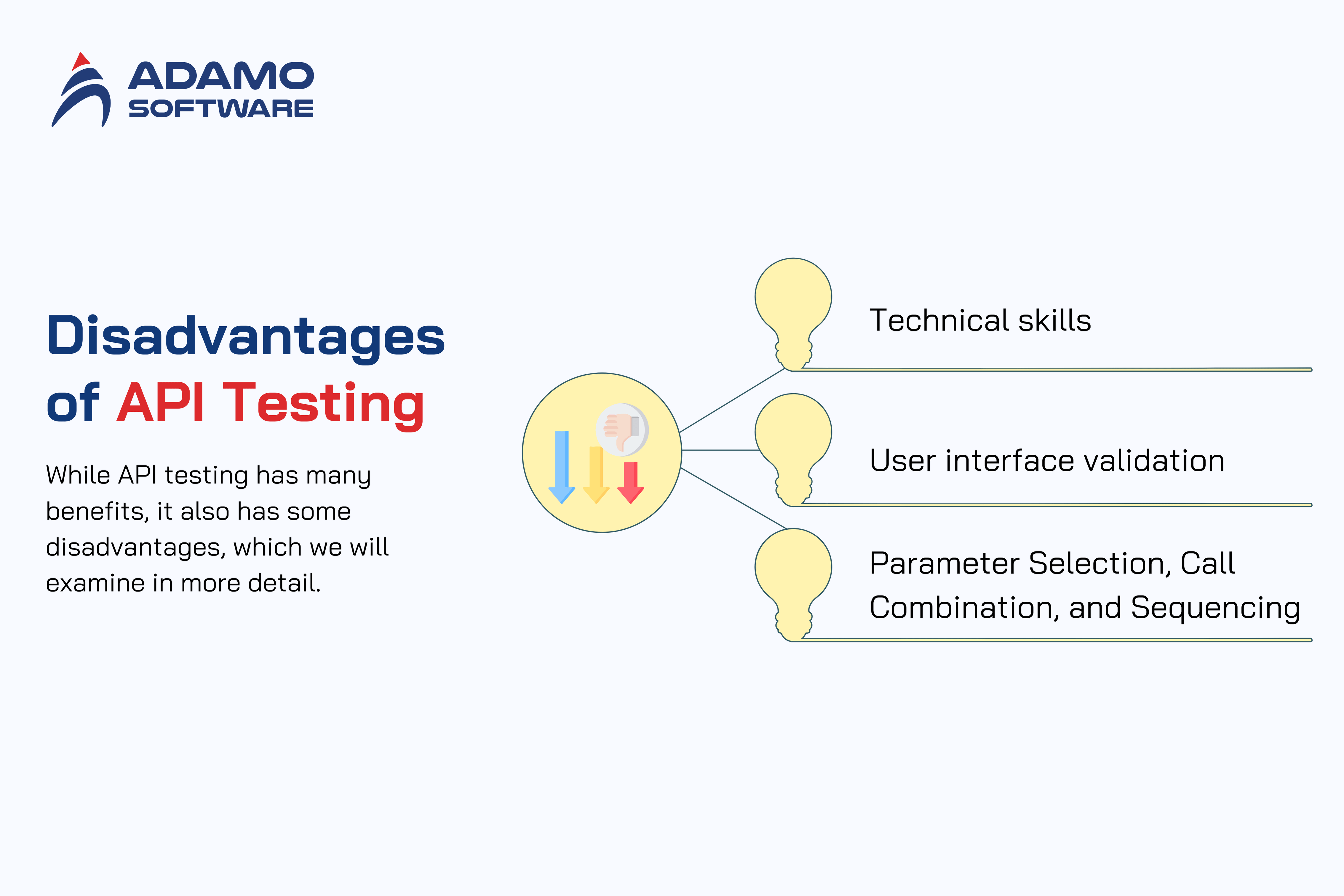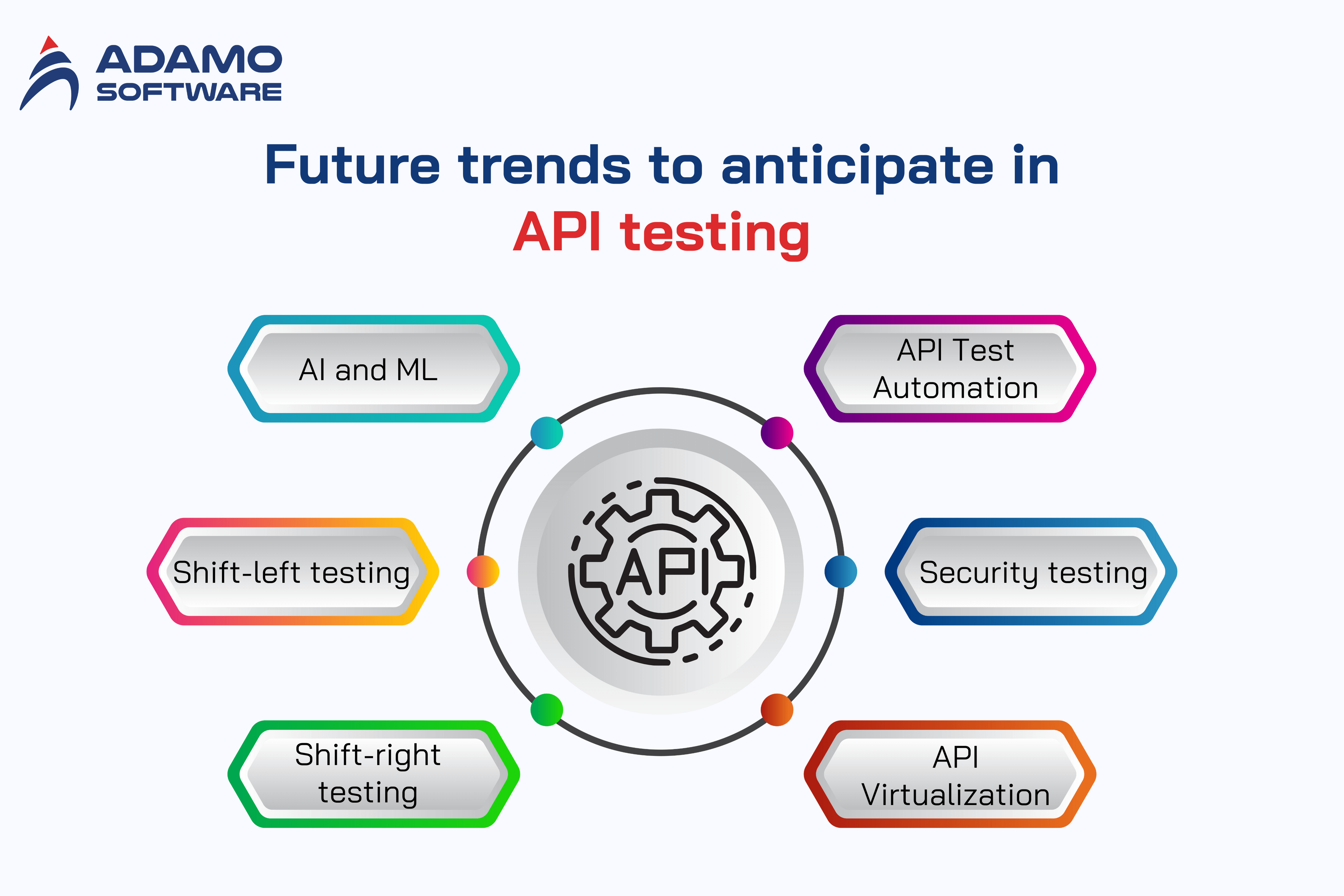Benefits of API in software testing: Top upcoming trends to look for

In the application development world, Application Programming Interfaces (APIs) enable communication and data exchange between software. Therefore, API testing is essential for integrating and delivering quality software or products. API testing in software is designed to withstand short release cycles and frequent changes. It also follows best practices for software development and IT operations.
With the rise of cloud computing, API in software testing is critical to the success of all businesses and organizations in the cloud. So, what exactly are the benefits of API in software testing?
In this blog, we have a closer look at the benefits of API automation that can be expected, as well as future trends to anticipate in API testing.
I. Top 7 advantages of API in software testing
API testing can potentially improve testing coverage and efficiency, system security, and more. Some of the benefits of performing this type of testing include:

1. Faster Releases
GUI testing is notorious for taking a long time to deliver a product. However, API testing has proven to be a quick fix that saves you much time. This allows you to focus on other core aspects of the software development process.
2. Better Test Coverage
It is best to test a car’s finish from the inside out rather than its paint job. Automated API testing goes deep into the layers below the UI to ensure that databases communicate correctly. System components are tested at the same time. And better test coverage means improved software quality and happy users.
3. Easy to pivot
API testing can be done quickly – no GUI is required. Developers can easily pivot to the left to get started, run tests, get immediate feedback, and resolve issues sooner. Compared to UI testing, API testing takes seconds, at most minutes, to complete.
4. Less maintenance
Changes to API classes are rare. They are not easily rolled back later due to recent mergers or releases, but they often occur due to significant updates to business logic. It is best to reflect the APIs that will be incorporated into the specifications and functions they are associated with from the start.
5. Faster debugging
Because API testing needs to work quickly to deliver a solution, you will know immediately whether the results are good or bad. This can help you diagnose problems earlier in development, allowing for efficient bug detection and removal.
6. Reduced Testing Costs
Since API testing covers more areas, is easier to maintain, and delivers rapid releases, testing costs are significantly reduced. Your time, money, and resources can be used for other purposes.
7. Understand the Common Language
Since data is exchanged via XML and JSON formats, all languages can be used in API testing. So, you are covered whether you prefer JavaScript, Java, Ruby, Python, or PHP.
II. Disadvantages of API Testing
While API testing has many benefits, it also has some disadvantages, which we will examine in more detail.

1. Technical Skills
Those who have never been exposed to APIs before may find it difficult to get started. Creating an API testing environment and developing and maintaining automated tests can be difficult. This requires the QA team to have some technical skills and often programming language experience.
The lack of a user interface for API testing can also confuse software testers without experience with API testing. Therefore, less experienced software testers may need time to become more familiar with the API and its testing process before starting the task.
2. User Interface Validation
In cases where testing is only performed at the API layer, you can be sure that the data is handled correctly, but that does not guarantee that the user can interact with the application in the expected way. API testing does not cover the risks of the user interface. Therefore, it is recommended that UI and API testing be combined.
3. Parameter Selection, Call Combination, and Sequencing
Data parameters sent via the API must be validated before being used. Testers must ensure that all parameter data meets security and validation requirements, including using appropriate string or numeric data, specific value ranges, and compliance with length restrictions.
Parameter combinations can be complex because each combination must be tested to see if it contains issues with specific configurations. Call sequencing can become a challenge since each call must occur in a particular order to ensure the system operates properly. This can quickly become problematic, especially when working with multithreaded applications.
Also read: How to secure api: The 10 most dangerous API risks to avoid
III. Solutions to cope with API testing challenges
Here are some solutions to address common software API testing challenges:
- Prioritize testing critical functionality to ensure comprehensive coverage.
- Include response time assertions in testing to validate performance.
- Identify and include API dependencies in test cases for comprehensive testing.
- Simulate different environments and real-world scenarios to ensure API reliability.
- Validate the accuracy and integrity of data returned by the API in your test cases.
- Handle authentication and security issues by testing multiple authentication methods and using strong encryption.
- Perform testing on various devices and platforms to confirm compatibility.
- Set up and manage environments similar to production for accurate test results.
- Use proper version control to handle API updates and maintain backward compatibility.
IV. Best uses cases of API testing
APIs in software testing are essential to ensure the application’s stability, performance, and security. Therefore, following best practices ensures comprehensive and effective API testing. In addition, it helps teams detect issues early and improve the overall quality of the application.

Below are the key best practices and real-world examples to illustrate each practice:
1. Test for various input scenarios
- Description: Test the API with different input conditions, including valid, invalid, empty, and boundary inputs, to ensure stability.
- For example: For an API that accepts date ranges, test valid ranges like 2022-01-01 to 2022-12-31, invalid formats like just 2022-01-01, and boundary values like 2022-12-31 to 2023-01-01.
2. Validate responses and status codes
- Description: Ensure that the API returns the correct HTTP status codes (e.g., 200 for success, 400 for invalid requests) and that the data in the response body is accurate.
- For example: For a GET request to fetch user details, verify that a valid request returns a 200 OK status with the user data, while an invalid user ID results in a 404 Not Found status.
3. Implement automated testing
- Description: Automate API tests to run continuously during development, especially within CI/CD pipelines, to catch issues early.
- For example: Use tools like Postman or Rest Assured to automate API test cases, such as for login functionality, ensuring each build verifies that the authentication API is working correctly.
4. Perform Security Testing
- Description: Test the API’s security measures like authentication (OAuth, JWT tokens), authorization, and encryption to prevent security vulnerabilities.
- For example: Try accessing restricted endpoints without an authentication token and ensure the API returns a 401 Unauthorized response.
5. Test API Performance Under Load
- Description: Conduct performance testing to check how the API handles high traffic and ensure scalability.
- For example: Use tools like JMeter to simulate hundreds or thousands of concurrent users making requests to the API and measure response times, ensuring it can handle peak traffic without crashing.
Following these practices ensures that your API testing is efficient and aligned with your application requirements. In addition, real-world testing scenarios help uncover functional, performance, and security issues early in the development cycle.
V. Future trends to anticipate in API testing
API in software testing serves as the backbone of modern technology. They act as a bridge that allows different software applications to communicate and collaborate seamlessly. That’s why they will grow in popularity in the future.
Here are 6 major trends that are set to shape the future, each of which plays a vital role in improving how we build, secure, and optimize software:
1. AI and Machine Learning
Around 62% of companies believe that AI will significantly impact the growth of API vulnerabilities in newly identified software testing. AI and ML are being integrated into API testing tools to automatically generate test cases, increase test coverage, and improve bug detection. These technologies enable the analysis of large data sets to identify patterns, anomalies, and potential areas for optimization, leading to efficient testing processes.
2. Shift-Left Testing
The trend of moving testing activities earlier in the software development life cycle (SDLC) continues to grow. Teams can identify and resolve issues earlier by integrating API testing into the development process from the beginning. This saves costs and effort. This approach can improve collaboration between developers and testers. It also fosters a culture of quality and speeds up time to market.
3. Shift-Right Testing
In addition to shift-left testing, there is also shift-right testing. It focuses on monitoring and testing applications in production environments. By continuously monitoring APIs in software testing during production, organizations can proactively identify issues, collect real-world performance data, and prioritize areas for improvement. Additionally, shift-right testing complements traditional testing methods and helps ensure that applications meet user expectations and deliver a seamless user experience.
4. API Test Automation
Automation continues to be a primary focus in API testing, as more organizations adopt automated testing tools and frameworks to optimize their testing processes. Automation enables teams to execute tests quickly and consistently, ensuring comprehensive coverage and faster feedback. CI/CD pipelines enhance automated testing by smoothly incorporating API tests into the development workflow.
5. Security Testing
The surge in API testing software and growing concerns about data security are driving the need for more robust API security testing. It has also led to the integration of security testing tools and techniques into API testing. Moreover, there is growing emphasis on securing APIs in software testing to address new threats, including API misuse, data breaches, and code injection attacks.
6. API Virtualization
API virtualization is another growing trend in AI testing, enabling teams to create virtual versions of APIs for testing purposes. APIs in virtual software testing simulate the behavior of real APIs, allowing testers to validate application functionality. It can also simulate different scenarios and integration testing without relying on external dependencies. API virtualization can reduce testing constraints, speed testing cycles, and improve test coverage.
VI. How Adamo Software conduct API in software testing
Adamo Software provides a robust API testing methodology that ensures that your APIs perform as intended and meet your business requirements, timeframes, and team skill sets right from day one. Our innovative tools support multiple protocols and formats, allowing users to create complex test cases through an intuitive drag-and-drop interface.

Furthermore, our API testing suite is flexible, allowing for reuse for load, performance, and security testing, helping to improve coverage and quality with minimal effort. Partner with Adamo to conduct your API in software testing.











